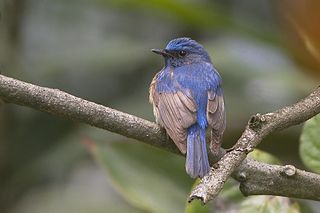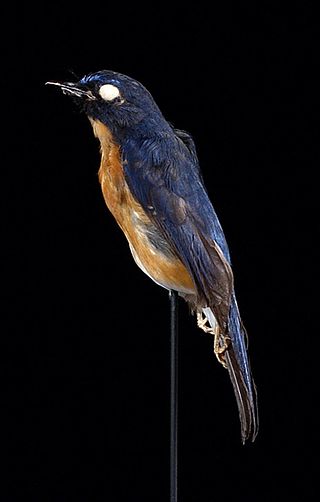
Tickell's blue flycatcher is a small passerine bird in the flycatcher family. This is an insectivorous species which breeds in tropical Asia, from the Indian Subcontinent eastwards to Bangladesh and western Myanmar. The Indochinese blue flycatcher was formerly considered conspecific. They are blue on the upperparts and the throat and breast are rufous. They are found in dense scrub to forest habitats. The name commemorates the wife of the British ornithologist Samuel Tickell who collected in India and Burma.

The blue-throated blue flycatcher is a small passerine bird in the flycatcher family, Muscicapidae. It resembles Cyornis tickelliae but easily separated by the blue throat. The habitat of this species is a thicker forest than other species of flycatchers. The blue-throated flycatcher is found in much of the Indian Subcontinent, all through the Himalayas, the plains and Western Ghats of India in the cold months, and also extends eastwards into Bangladesh, and to Arakan and the Tenasserim Hills in Myanmar.

Rück's blue flycatcher is a passerine bird in the Old World flycatcher family Muscicapidae. It is known from only four specimens and is endemic to a small area in northeast Sumatra, Indonesia, inhabiting primary lowland forest. Although all specimens share common characteristics, such as a black bill, brown iris, and black feet, two of the collected specimens show some physical discrepancy with the other two. They were initially described as Cyornis vanheysti before being accepted as specimens of C. ruckii. Rück's blue flycatcher has also been compared to other species of Cyornis.

Cyornis is a genus of birds in the Old World flycatcher family Muscicapidae most of which are native to Southeast Asia.

The Sunda blue flycatcher, also known as the large-billed blue-flycatcher, is a species of bird in the family Muscicapidae. It is found in Sumatra and Borneo. Its natural habitat is subtropical or tropical moist lowland forests. It is threatened by habitat loss.

The white-tailed flycatcher is a species of bird in the family Muscicapidae. It is the only member of the monotypic genus Leucoptilon. Prior to 2022, it was classified in the genus Cyornis, but was reclassified into Leucoptilon by the International Ornithological Congress based on a 2021 phylogenetic study.

The hainan blue flycatcher is a bird in the family Muscicapidae. The species was first described by William Robert Ogilvie-Grant in 1900. It is found in Cambodia, China, Hong Kong, Laos, Myanmar, Thailand, and Vietnam. Its natural habitat is subtropical or tropical moist lowland forests.

The blue-breasted blue flycatcher, also known as the blue-breasted flycatcher, is a species of bird in the family Muscicapidae. It is endemic to the Philippines. Its natural habitat is subtropical or tropical moist lowland forests. The rufous-breasted blue flycatcher was formerly considered to be a subspecies.

The Palawan blue flycatcher is a species of bird in the family Muscicapidae. It is endemic to the Philippines.

The Sulawesi blue flycatcher is a species of bird in the family Muscicapidae. It is endemic to Indonesia. Its natural habitats are subtropical or tropical moist lowland forests and subtropical or tropical moist montane forests.

The pale-chinned blue flycatcher or Brook's flycatcher is a species of bird in the family Muscicapidae. It is a sparrow-sized bird. Male is bluish-grey on upper parts, rufous throat and white below. Its nesting season is April–June.

The mangrove blue flycatcher is a species of bird in the family Muscicapidae. It is native to Brunei, Indonesia, Malaysia, the Philippines, Sri Lanka, Singapore, and Thailand. Its natural habitat is subtropical or tropical mangrove forests. Clements splits the Kalao blue flycatcher, Cyornis kalaoensis into a distinct species. The IOC still lists it as a subspecies of the mangrove blue flycatcher.

The Matinan blue flycatcher, also known as the Matinan flycatcher, is a species of bird in the family Muscicapidae. It is endemic to the island of Sulawesi in Indonesia. Its natural habitat is subtropical or tropical moist montane forests, and the species is threatened by habitat loss.

The Bornean blue flycatcher is a species of bird in the family Muscicapidae. It is found in Brunei, Indonesia, and Malaysia, where it is endemic to the island of Borneo. Its natural habitat is subtropical or tropical moist montane forests.

The pale blue flycatcher is a bird in the family Muscicapidae. The species was first described by Edward Blyth in 1843.

The brown-chested jungle flycatcher is a species of bird in the Old World flycatcher family Muscicapidae. It breeds in South China ; its winters in the Malay peninsula. Its natural habitats are subtropical or tropical moist lowland forests and subtropical or tropical mangrove forests. It is threatened by habitat loss.

The Sula jungle flycatcher is a species of passerine bird in the Old World flycatcher family Muscicapidae. It is endemic to Sula Island in Indonesia where its natural habitat is subtropical or tropical moist lowland forests. It is threatened by habitat loss.

The fulvous-chested jungle flycatcher is a species of bird in the Old World flycatcher family Muscicapidae. It is found in Brunei, Indonesia, Malaysia, Myanmar, and Thailand. Its natural habitat is subtropical or tropical moist lowland forests.
The Philippine jungle flycatcher is a species of passerine bird in the Old World flycatcher family Muscicapidae. It is endemic to the Philippines. Its natural habitat is subtropical or tropical moist montane forests.

The grey-chested jungle flycatcher is a species of bird in the Old World flycatcher family Muscicapidae. It is found in Brunei, Indonesia, Malaysia, and Thailand. Its natural habitats are subtropical or tropical moist lowland forests and subtropical or tropical swamps. It is threatened by habitat loss.




















